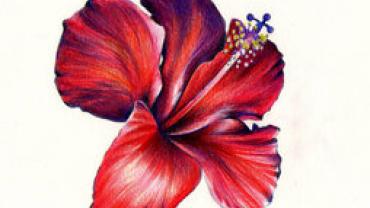
"
Hibiscus is an herbaceous plant well known for its showy magenta blossoms that not only sport external beauty but also an array of health benefits. Gardeners may strategically use these flowers to attract nature while Hawaiian and Tahitian women adorn their hair with hibiscus blossoms to attract the opposite sex (or declare themselves taken!); however the chemical compounds residing within those beautiful petals are far more attractive to those seeking health and wellness.
Several species of hibiscus can be found around the globe but Hibiscus sabdariffa (otherwise known as Roselle) is the dominating species in the medicinal world. The compounds housed within the flowers consist of a hearty dose of fruit acids such as citric acid malic acid and tartaric acid. Additional adjunct compounds include anthocyans that are responsible for the characteristic red hue of this plant flavonoids and mucilages such as arabinogalactans. These beneficial components are most often delivered in the form of tea. A quick look at the ingredient list of nearly any common herbal tea concoction will prove the popularity of this herbaceous plant. Due to the presence of anthocyans hibiscus will turn any beverage a colorful pink or red making it a common choice for brightly colored iced tea during the summer.
Cardiovascular protection
Therapeutically Hibiscus sabdariffa has been studied most rigorously for its purported ability to act as a hypertensive and less commonly to lower cholesterol. A recent review of several randomized clinical trials using Hibiscus sabdariffa worldwide for the treatment of hypertension and hyperlipidemia verified these effects via a number of mechanisms and recommended further testing to define clinical recommendations for its use. Lack of reported toxicity adverse effects or side effects makes it even more alluring as a treatment for these common health conditions. The various trials identified anthocyans and potentially polyphenols and hibiscus acid as being the primary compounds responsible for both antihypertensive and hypocholesterolemic effects. Anthocyan being a potent antioxidant may effectively reduce oxidation of LDL cholesterol and subsequent atherosclerosis. The diuretic effect of hibiscus could also aid in its ability to significantly lower systolic and diastolic blood pressure in those with essential hypertension and type 2 diabetes. Daily consumption of hibiscus tea showed promising results as did administration of an extract in a dose dependent manner.
Antioxidant properties
The antioxidant effects of hibiscus have been well studied in several clinical situations making this herb useful for a number of conditions. In one study Hibiscus sabdariffa has been shown to protect red blood cells from oxidative stress in diabetic-induced mice. Phenolic compounds and anthocyan from Hibiscus sabdariffa were able to protect DNA from oxidative damage in another study. When gentamicin was used to induce nephrotoxicity in rats Hibiscus sabdariffa was able to effectively reduce serum creatinine urea kidney GSH and catalase ameliorate the nephrotoxicity and prove itself to possess nephroprotective effects.
UTIs
Speaking of kidneys Hibiscus sabdariffa may just be a good friend to the entire urinary tract. Candiduria a Candida albicans urinary tract infection (UTI) and other fungal UTIs are growing at alarming rates and limited options for treatment are available. Many antifungal agents have undesirable side effects and fungal resistance to the few pharmaceuticals available is a growing concern. Therefore herbal antifungals are quickly gaining interest. In one study seeking to determine whether Hibiscus sabdariffa extract was effective against C. albicans isolated from the urinary tract it was found that not only did Hibiscus sabdariffa extract inhibit the growth of C. albicans but it also inhibited the production of its biofilm an important element in creating a persistent fungal infection. The phenolic compounds such as flavonoids found in hibiscus have potent antimicrobial effects and the proanthocyanidin is responsible for inhibiting biofilms. Interestingly hibiscus contains the same proanthocyanidin found in cranberry extract (commonly used for bacterial UTIs) making it useful for all types of UTIs.
So the next time you find yourself reaching for a cup of tea whether steaming hot or ice cold consider relaxing with a cup of hibiscus. Not only will the extra dose of antioxidants help keep your cells strong and healthy but your kidneys and urinary tract will also thank you for the health benefits this herb provides.